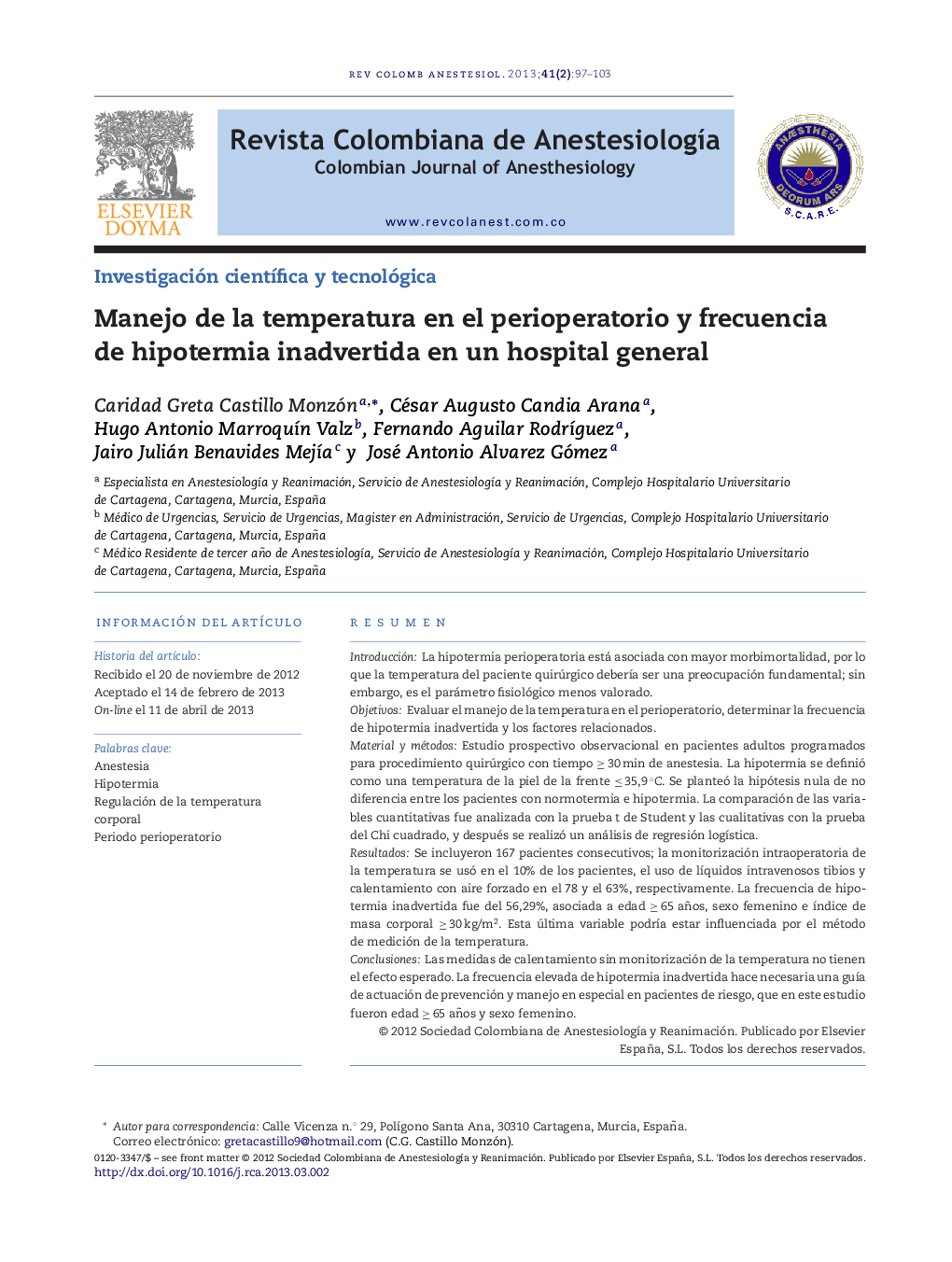| کد مقاله | کد نشریه | سال انتشار | مقاله انگلیسی | نسخه تمام متن |
|---|---|---|---|---|
| 2767632 | 1151206 | 2013 | 7 صفحه PDF | دانلود رایگان |

ResumenIntroducciónLa hipotermia perioperatoria está asociada con mayor morbimortalidad, por lo que la temperatura del paciente quirúrgico debería ser una preocupación fundamental; sin embargo, es el parámetro fisiológico menos valorado.ObjetivosEvaluar el manejo de la temperatura en el perioperatorio, determinar la frecuencia de hipotermia inadvertida y los factores relacionados.Material y métodosEstudio prospectivo observacional en pacientes adultos programados para procedimiento quirúrgico con tiempo ≥ 30 min de anestesia. La hipotermia se definió como una temperatura de la piel de la frente ≤ 35,9 °C. Se planteó la hipótesis nula de no diferencia entre los pacientes con normotermia e hipotermia. La comparación de las variables cuantitativas fue analizada con la prueba t de Student y las cualitativas con la prueba del Chi cuadrado, y después se realizó un análisis de regresión logística.ResultadosSe incluyeron 167 pacientes consecutivos; la monitorización intraoperatoria de la temperatura se usó en el 10% de los pacientes, el uso de líquidos intravenosos tibios y calentamiento con aire forzado en el 78 y el 63%, respectivamente. La frecuencia de hipotermia inadvertida fue del 56,29%, asociada a edad ≥ 65 años, sexo femenino e índice de masa corporal ≥ 30 kg/m2. Esta última variable podría estar influenciada por el método de medición de la temperatura.ConclusionesLas medidas de calentamiento sin monitorización de la temperatura no tienen el efecto esperado. La frecuencia elevada de hipotermia inadvertida hace necesaria una guía de actuación de prevención y manejo en especial en pacientes de riesgo, que en este estudio fueron edad ≥ 65 años y sexo femenino.
IntroductionPerioperative hypothermia is associated with increased morbidity and mortality. Consequently, surgical patient temperature should be the fundamental concern but, nonetheless, it is still the least valued physiological parameter.ObjectivesTo assess temperature management during the perioperative period and determine the frequency of inadvertent hypothermia and related factors.Material and methodsProspective observational study in adult patients scheduled for surgical procedure with anesthesia time ≥ 30 minutes. Hypothermia is defined as a forehead skin temperature ≤ 35.9 °C. The null hypothesis of no difference between patients with normothermia and hypothermia was proposed. Comparison of quantitative variables was analyzed with the Student “t” test, and the Chi square was used for the qualitative variables. The analysis was followed by a logistic regression analysis.ResultsWe included 167 consecutive patients; intraoperative monitoring of temperature was used in 10% of patients, and the use of warm intravenous fluids and forced air heating in 78% and 63%, respectively. The frequency of inadvertent hypothermia was 56.29%, associated with age ≥ 65 years, female gender and BMI ≥ 30 kg/m2. This last variable might have been influenced by the method of temperature measurement.ConclusionWarming measures without temperature monitoring do not result in the desired effect. The high frequency of inadvertent hypothermia requires action guidelines for prevention and management, especially in high-risk patients who, in this study, were patients ≥ 65 years of age and females.
Journal: Revista Colombiana de Anestesiología - Volume 41, Issue 2, April–June 2013, Pages 97–103